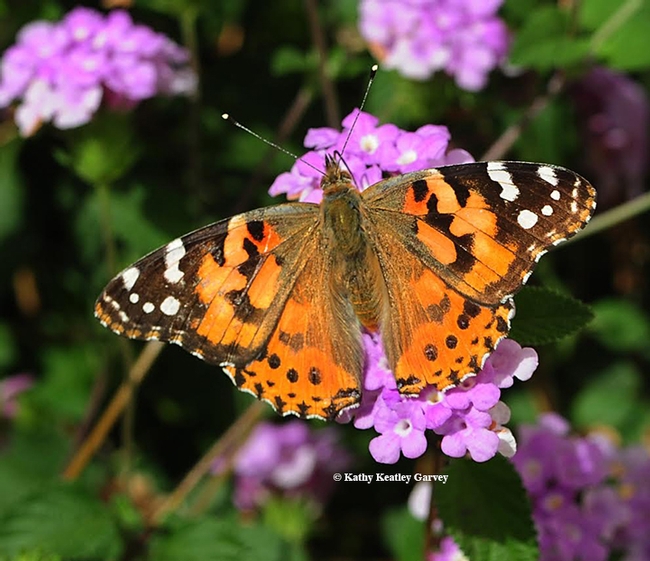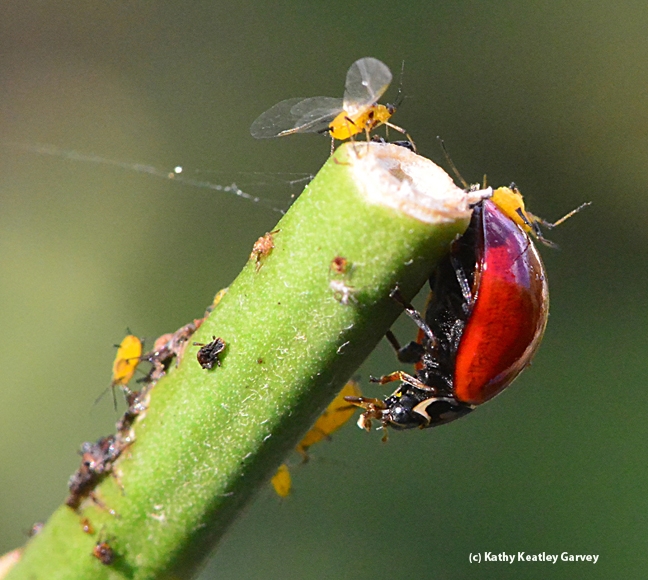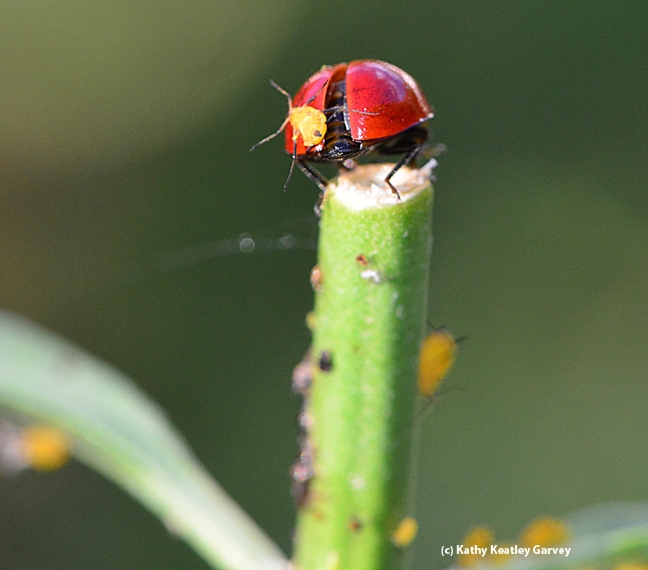- Author: Kathy Keatley Garvey
The painted ladies are on the move.
Have you seen these migratory butterflies, Vanessa cardui, passing through California on their way to the Pacific Northwest?
Me? No! Zero. Zilch. Zip.
But butterfly guru Art Shapiro, distinguished professor of evolution and ecology, who has monitored the butterfly population of Central California for more than four decades and maintains a research website, has seen approximately 400 painted ladies this season--about 300 today.
All I saw today was a lone cabbage white butterfly flying through our pollinator garden in Vacaville.
Guess the painted ladies didn't get the message. The New York Times, did, though.
"The orange butterflies, called painted ladies, are known to travel annually from the deserts of Southern California to the Pacific Northwest," wrote New York Times reporter Julia Jacobs in a March 17th piece. "This month, people are taking notice because of the sheer size of the migration: Scientists estimate the teeming painted ladies number in the millions."
"Substantial rainfall in the deserts near the Mexican border, where the North American painted ladies lay their eggs, is the reason for the unusually large swarms," Jacobs pointed out. "The rain caused plants to thrive, giving the painted lady caterpillars plenty of food to fuel their transformation, said Art Shapiro, a professor of evolution and ecology at the University of California, Davis."
Shapiro told the New York Times that "the striking thing is they're moving very rapidly and directionally. So it's almost like being in a hail of bullets.”
They're passing through Davis, too. Shapiro headed over to the UC Davis Memorial Union patio today and noticed that "the painted ladies are on the upswing. Many are nectaring, suggesting they're running out of fat, but despite the abundance of potential hosts, saw no oviposiiton. Condition extremely variable, from beat-to-hell to looking almost fresh."
The professor witnessed them passing by the Memorial Union "roughly one every 90 seconds." Ironically, no one seemed to notice them, Shapiro said. Well, it is finals week!
The Los Angeles Times reported March 11 that a "massive swarm of at least 1 billion butterflies is traveling across Los Angeles and neighboring counties at a breathtaking speed of almost 20 miles an hour." They're in a "rush to reach their breeding areas in Oregon."
Shapiro says that years of tremendous wildflower blooms are typically big years for the butterflies. The last big year was 2005. He explains the phenonomen on his website:
"This mass-migrant occurs in much of the Northern Hemisphere. Apparently the entire North American population winters near the US-Mexico border, breeding in the desert after the winter rains generate a crop of annual Malvaceous, Boraginaceous and Asteraceous hosts. The resulting butterflies migrate north. In good years (lots of desert rain) they may do so by billions, interfering with traffic and attracting the attention of the media. 2005 was one of the biggest Painted Lady years in history--perhaps the biggest, but how can we know? At Sacramento at the height of the migration butterflies were passing in one's field of vision at the rate of about 3 per second! 2006, by contrast, was a La Nina year with very little rain in the desert. The butterflies apparently gave up trying to breed there and flew north in February. They tried to breed but mostly were unsuccessful due to bad weather, resulting in only very sporadic individual sightings of their progeny in May.
"Northward-migrating Painted Ladies are provisioned with yellow fat and are reproductively immature," he writes. "They do not stop to feed or have sex until they have burned up their reserves, carried over from the caterpillar stage. They fly in a straight line from SE to NW, like 'bats out of Hell,' and go over obstacles rather than trying to go around them. (On certain days there may be concerted local movements in the wrong direction. We do not understand these.) Painted Ladies tend to fly parallel to the Sierra Nevada, not across it. They enter the Central Valley through the Inyo-Kern lowland or by crossing the Transverse Ranges. They can apparently make it from Bishop to Davis in three days. In some years the migration is heavier in the Great Basin and on the East slope of the Sierra than farther west.
"The Painted Lady moves northward in a generational wave as the season progresses. Frequently it disappears altogether from the lowlands in summer. Beginning in August the movement reverses and butterflies head south toward the desert wintering grounds. The southward migration is a more protracted affair, with plenty of adult feeding and some breeding en route. Numbers tend to be highest east of the crest, on Rabbitbrush blossoms in October."
Well, maybe tomorrow one or more painted ladies will fly my way. Preferably more.
Shapiro just received word of "a major movement through the Kern River Valley. Inyo-Kern is the superhighway from the desert to the Central Valley, so the biggest numbers may yet be on the way."

- Author: Kathy Keatley Garvey
Oleander aphids, those cartoonish-looking yellow insects with black legs and cornicles, are commonly found on oleanders. Hence their name. But they also are partial to milkweeds, the host plant of the monarch butterfly.
It's a daily challenge to rid those Draculalike pests from our milkweed plants. They pierce the tender stems and suck out the plant juices. Hey, do you mind? Those milkweeds are reserved for monarchs!
Fortunately, lady beetles, aka lady bugs, come to the rescue! Unfortunately, lady beetles also dine on monarch eggs.
It's a case of predator vs. prey (lady beetles vs. aphids) and beneficial insect vs. beneficial insect (lady beetles vs. monarch eggs).
Today something a little more unusual happened.
An oleander aphid hitched a ride on the back of a lady beetle. Apparently unaware of the hitchhiker (fast food at that!), the lady beetle kept gobbling up the aphid's relatives in an all-you-can-eat buffet.
We watched the lady beetle scurry up and down the mllkweed and then take off with the aphid securely on its back.
The lady beetle became the pilot, and the aphid, the passenger. The fair game became a free fare.
How do you control aphids on milkweed but still keep the monarch eggs?
An article appearing Nov. 9, 2012 in the Los Angeles Times had this to say:
"Monarch eggs are more tightly attached to leaves than aphids, so with just the right amount of pressure you may be able to wash off aphids without destroying the eggs.Sprayed water may only dislodge the pests, which can climb back up on their own or be returned by aphid-harvesting ants. Soapy water may dislodge and kill more aphids, but it also is more damaging to the monarchs and can build up on the plant."
"Though tedious, dabbing aphids with cotton swabs dipped in isopropyl (rubbing) alcohol is most effective. That kills them outright. Alcohol, however, also is lethal to monarch eggs and larvae, so care must be taken when dabbing."
For more about aphids, be sure to read the UC Statewide Integrated Pest Management's Pest Note. Be aware that aphids are not just sucking pests. They can also transmit viruses. "Squash, cucumber, pumpkin, melon, bean, potato, lettuce, beet, chard, and bok choy are crops that often have aphid-transmitted viruses associated with them. The viruses mottle, yellow, or curl leaves and stunt plant growth."






